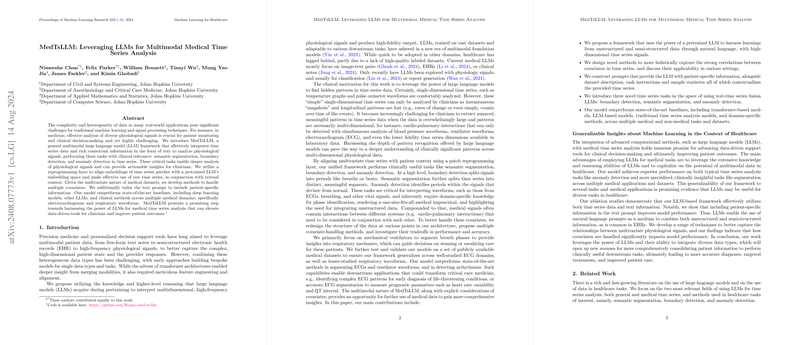MedTsLLM: Leveraging LLMs for Multimodal Medical Time Series Analysis
The paper "MedTsLLM: Leveraging LLMs for Multimodal Medical Time Series Analysis," presents MedTsLLM, an innovative framework that applies LLMs to the challenging domain of medical time series analysis. The proposed model seeks to integrate various physiological signals with rich textual patient information, enabling more nuanced and actionable insights for clinical decision-making. This summary aims to delve into the methodologies, results, and implications of this framework, addressing its multidisciplinary approach and future potential within clinical settings.
Key Contributions
MedTsLLM stands out for its ability to perform three key tasks relevant to medical time series data: semantic segmentation, boundary detection, and anomaly detection. These tasks are vital for interpreting physiological signals and influencing clinical decisions.
The main contributions of the paper include:
- Framework Design: A novel approach uses pretrained LLMs to handle both high-dimensional time series signals and textual context.
- Multivariate Covariate Handling: Introduction of methods to capture relations between covariates, which enhances the model's performance when dealing with complex medical datasets.
- Prompt Generation: Efficient prompting strategies to incorporate patient-specific information alongside dataset descriptions and task instructions.
- Task Solver Development: Implementation of specialized methods for semantic segmentation, boundary detection, and anomaly detection using LLMs.
- Performance: Demonstrated superior performance over state-of-the-art models across multiple medical domains, including ECG and respiratory waveforms.
Methodology
The methodology comprises four core components:
- Prompt Generation: The framework constructs prompts that combine dataset descriptions, task instructions, patient-specific data, and summary statistics. This ensures the LLM is well-informed and can leverage its pretraining effectively.
- Time Series Encoding: A reprogramming layer aligns the time series data's embedding space with that of the pretrained LLM, addressing distribution gaps and enabling efficient utilization of multimodal data.
- LLM Backbone: Utilized state-of-the-art LLMs such as LLaMA 2 (7B), leveraging their pretrained weights while keeping them frozen during training to mitigate computational demands. Different LLMs can be integrated into this framework, making it versatile.
- Task-Specific Output Layers: Tailored projection and processing layers were used to adapt the LLM outputs for semantic segmentation, boundary detection, and anomaly detection.
Results
The framework was evaluated across multiple datasets:
- Ventilator Waveforms: Achieved 98.92% F1 score for semantic segmentation, outperforming domain-specific models.
- LUDB Dataset for ECG Analysis: An 81.73 IoU score for semantic segmentation, higher than other state-of-the-art models.
- BIDMC Respiratory Signals: Delivered the best mIoU and lowest mean absolute error (MAE) for boundary detection amongst compared models.
- MIT-BIH: Showcased its robustness in both boundary detection and anomaly detection, with F1 and AUROC scores of 94.70 and 98.52, respectively.
Technical Implications
MedTsLLM demonstrates the feasibility of employing LLMs for complex, multivariate time series analysis. Handling covariates effectively was shown to be crucial, with the interleave and concatenate strategies performing best. The paper also underscores the importance of effective prompt engineering; however, excessive prompt complexity can hinder performance, a nuanced challenge for future work.
Clinical Implications
Clinically, the framework shows promise in enhancing automated analysis for critical care monitoring systems, cardiology, and pulmonology. By integrating physiological signals with patient-specific textual data, MedTsLLM enables tailored and timely clinical insight. For instance:
- ECG Analysis: Accurate segmentation and anomaly detection can aid in early diagnosis of cardiac conditions.
- Ventilator Waveform Analysis: The ability to segment breath phases and detect anomalies can optimize ventilator settings, potentially improving patient outcomes in intensive care.
Future Directions
There are several areas for future exploration:
- Interpretability: Efforts are needed to enhance the interpretability of LLM-based models to build clinician trust.
- Computational Efficiency: Optimizations like quantization and key-value caching could make the model more accessible in resource-constrained settings.
- Expanding Modalities: Incorporating additional data modalities from EHRs, such as clinical notes and imaging data, could further refine patient-specific insights.
- Domain Specialization: Training or fine-tuning LLMs on larger, domain-specific datasets could help to specialize their predictive capabilities further.
Conclusion
MedTsLLM presents a compelling method that bridges advanced computational methods with practical clinical applications. By leveraging the power of LLMs, it achieves superior performance in analyzing complex medical time series data, thereby paving the way for more accurate and actionable clinical insights. This framework holds substantial promise for enhancing patient monitoring systems and supporting more informed medical decision-making.
